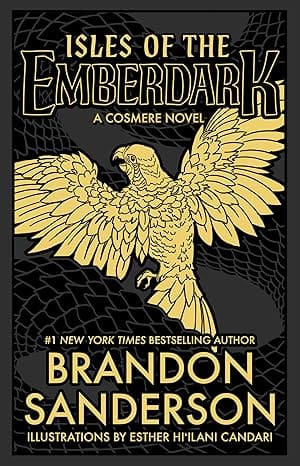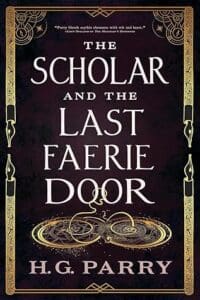
Synopsis:
All his life, Sixth of the Dusk has been a traditional trapper of Aviar—the supernatural birds his people bond with—on the deadly island of Patji. Then one fateful night he propels his people into a race to modernize before they can be conquered by the Ones Above, invaders from the stars who want to exploit the Aviar.
But it’s a race they’re losing, and Dusk fears his people will lose themselves in the effort. When a chance comes to sail into the expanse of the emberdark beyond a mystical portal, Dusk sets off to find his people’s salvation with only a canoe, his birds, and all the grit and canniness of a Patji trapper.
Elsewhere in the emberdark is a young dragon chained in human Starling of the starship Dynamic. She and her ragtag crew of exiles are deep in debt and on the brink of losing their freedom. So when she finds an ancient map to a hidden portal between the emberdark and the physical realm, she seizes the chance at a lucrative discovery.
These unlikely allies might just be the solution to each other’s crisis. In their search for independence, Dusk and Starling face perilous bargains, poisonous politics, and the destructive echo of a dead god.
Sanderson expands his thrilling novella “Sixth of the Dusk” into a mythic novel of legends, lore, and warring galactic superpowers.
Review:
When I was in high school, one of my favorite stories was Nightfall by Isaac Asimov, a 1941 short story that was later recognized by the Science Fiction Writers of America as the best science fiction short story written prior to the establishment of the Nebula awards in 1965. It took almost half a century, but eventually Asimov teamed up with Robert Silverberg and adapted Nightfall into a full-length novel. Both are fantastic, but the novel wouldn’t exist without the short story which preceded it.
Brandon Sanderson’s latest novel Isles of the Emberdark has similar roots. The basis for the book is his 2014 novella Sixth of the Dusk, which I had not read before opening Emberdark. Of course, he didn’t wait nearly 50 years to expand his story like Asimov did, but the end result is a wonderful and emotional addition to Sanderson’s ever-expanding Cosmere, taking us to yet unexplored places in his universe. Now, this isn’t going to be a comparison between Emberdark and Nightfall, but as I thought about each of the stories, I realized that both share some fascinating DNA in the form of themes and ideas. Perhaps I’ll take a closer look at that another time.
But for now, let’s look at Isles of the Emberdark. The book is the latest “Secret Project” from Brandon Sanderson. If you aren’t familiar with his Secret Projects, let me give you a quick backstory. Sanderson is…prolific. If he isn’t churning out a book ever other month, he’s working on half-million word Stormlight tomes. But that writing pace also includes all the promotional trips he makes as well. So…when the COVID-19 Pandemic hit in March 2020, Sanderson found himself stuck at home with no Conventions to go to. In March 2022, he announced that in addition to his normal writing output, he also “secretly” wrote FOUR new novels – Tress of the Emerald Sea, The Frugal Wizard’s Handbook for Surviving Medieval England, Yumi and the Nightmare Painter, and The Sunlit Man. At the time he announced them, he announced a Kickstarter to produce special editions of each and then ran the biggest Kickstarter event up until the last few months.
Those books were then produced throughout 2023 and then Brandon was back to normal. Well…up until last year when he ran another campaign for producing leatherbound editions of Words of Radiance and just dropped the fact that he’d written a FIFTH “Secret Project” Novel. That book is Isles of the Emberdark, which was sent to backers on July 1 and will be widely available in ebook and audiobook on July 10.
This is also the first novel that Sanderson has released since the fifth book in his Stormlight series released late last year. Wind and Truth came out to a lot of hype and fanfare and has received mixed reactions. Just like with the Marvel Cinematic Universe flicks, some of his Cosmere books, particularly the Stormlight books are weighed down by all that came before them and that seemed to really affect Wind and Truth for those that critiqued it.
What I will say about Isles of the Emberdark is…that weight is largely absent. The book is most definitely a Cosmere book, but we’re so far into the future from Mistborn and The Way of Kings that it feels vastly different. In fact, this is more of a Cosmic Science Fiction novel rather than an Epic Fantasy (although there are definitely threads of that clinging on here as well).
If you’ve read any Sanderson sequel, there is almost a comfort to the setting and the characters — a security blanket of sorts. Once we get into any Stormlight book after the first one I find myself adrift at times until I find Kaladin and then I’m settled in.
Here, that security blanket is turned on its head. The aspects of Isles of the Emberdark that I felt more comforted and secure in were not the larger Cosmere, instead I was grounded by the story of Dusk and his people. Now, as I said, I hadn’t read Sixth of the Dusk before diving in, but Sanderson accounted for that and built the novella into the novel, providing it as flashbacks in the opening quarter of the book. Along with the original novella, Sanderson deftly takes the first act to set up the current issues and political climate of Dusk’s planet — First of the Sun — five years after the events of Sixth of the Dusk.
As the protagonist, Dusk makes you feel at home whenever he’s on the page, grounding the very cosmic story. We see Scadrians and Rosharans and others from across the Cosmere, but since this is set in the far-future of Sanderson’s universe, they are so foreign to the reader that any connection to previous books is about nil. I don’t want this review to get too long, but I don’t want to not mention Starling, a dragon who is forced into human form, and her crew of misfits. There are so many crumbs that Sanderson is dropping with just these characters and where they come from for future books and stories and I hope I get to see the Dynamic again.
As Dusk seeks to protect his planet from the threat of the “Ones Above”, he must go on a journey to connect with the origins of his entire planet, and in doing so, there are a few themes that really hit me. First, Dusk and his people base their beliefs on oral storytelling. Dusk is a true believer, reinforced by his experiences on the deadly island of Patji. Later after he encounters the “more advanced” aliens from Scadrial, he’s mocked for his “primitive” ways and is even told that his oral stories can’t be as reliable as those written down. In the end, Dusk proves the power of storytelling and the belief one has in the stories they have — that sometimes we manifest our own reality with the stories we tell.
When the book starts, Dusk’s planet is probably around a mid-1800’s technology in many ways and even then they’ve been pushed to that capability by advances the Scadrians have left behind. As he goes on his journey, it seems as though the only way for Dusk to protect his people is through some super advanced tech he’ll find elsewhere in the Cosmere, but by the time the novel is wrapping up, we see that sometimes you don’t need the latest technology to solve your problems. Dusk knows his planet needs to advance, but with advances, you also need to recognize what came before.
So the big question — what do you need to know about the Cosmere? Really…I think you can mostly walk in with little to no knowledge of the larger universe and you’d have a delightfully great book on your hands. If you know a little more, it’ll have more payoff, but since the timeline of this book is so far ahead of what Sanderson has done so far, the ramifications are probably still to come for most readers. I’ll say that while I know a decent amount about the larger Cosmere…I’m not going to lie, I’ve got Coppermind (the Brandon Sanderson Wiki) open in another tab as I write this review.
Overall, I highly recommend Isles of the Emberdark. Sanderson has a natural way to get you invested early with his characters and through top-notch pacing keeps you going from start to finish. Isles of the Emberdark had me hooked early all the way to when his famous “Sanderlanche” happened, and from there it was all hands on deck until I got to the last page. I think Tress of the Emerald Sea might still be the best of the Secret Project books, but this is a fantastic book and a great stand-alone novel set in Sanderson’s wildly inventive Cosmere universe.









Leave a Reply